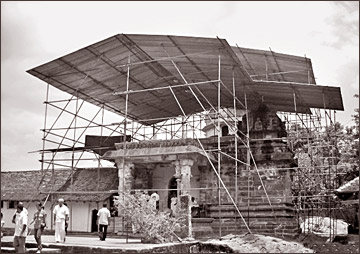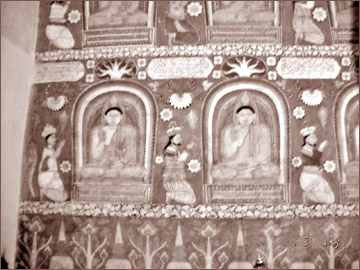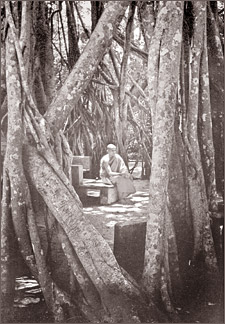|
Buddhist Spectrum
Gadaladeniya frescoes fade into oblivion
Priyanka Kurugala
One attractive national heritage site is Digana situated on a flat
rock in Kandy. Those who need to study our Sri Lankan arts should never
forget this important and historical place. The paintings are rich in
colours, pictures two-dimensional. The Buddha statues, built with large
open eyes, are directly related to the Kandyan period.
|
 
Temple being refurbished |
This temple site, Gadaladeniya, faces a pathetic situation with lack
of attention of the authorities. Water seeps through vanishing the
traces of the frescoes inside the main temple building. The Vijaya thupa
is a special feature among the other Thupas of the country.
There are four doors to enter four Devalas, but the Thupa is located
at the centre on four pills above the Devalas. The interior of this
Thupa, along with paintings, too have been damaged because of the water
seeping.
Other buildings situated in this sacred site are a sorry sight as
well, with some of them deserted. Roofs and some other walls have aged;
if not maintained good and proper, they will not get back the beauty and
serenity.
The Central Cultural Fund (CCF) has built a roof in 2001, which
shelters the main building. If the CCF has spent Rs. 15000 on a watcher
on monthly basis since 2001 it would amount to Rs. 16200000 by now,
which would have been better utilized on the temple conservation, opine
the residents. Other buildings in the vicinity are on the verge of
destruction as well, to make things worse.
Authorities have not taken single proper action to conserve these
buildings either, according to the temple sources. Visitors have access
to a few frescoes in the interior of the Gadaladeniya temple.
The temple authorities are reluctant to take any conservation action,
because the site comes under the purview of Archaeological Department.
The temple’s Chief Incumbent Ven. Akiriye Ariyakiththi Thera has made a
number of requests for conservation which yielded but meagre.
People are not interested in entering the old temple hence the
frescoes will go into oblivion. This is primarily because the floor
tiles have not been fixed properly.
“Authorities should mainly pay their attention to the Vijaya Thupa.”
Ven. Thera said.
|

Vanishing frescoes Pictures by Jagath Kurugala |
The plan of the main building is completely of Indian origin. The
temple belongs to the Gampola period. According to historical evidence
it was a built by King Buwanekabahu IV in 1344. The chief architect was
a South Indian called Ganesvarachari. This history makes the public view
the temple as a Hindu Kovil.
The main temple building has a seated Buddha statue under a Makara
Thorana and four standing Buddha images. The Makara Thorana is decorated
on both faces with gods such as Brahma, Suyama, Santhusuta, Natha,
Maithree and two attendants.
Central Cultural Fund Director General Professor Nimal de Silva told
the Daily news that they have taken steps to commence the conservation
program of the Gadaladrniya temple.
The conservation program will initiate in January, 2011. The
authority has allocated Rs. 8 millions for the renovation program. The
Vijaya thupa conservation program is now completed.
However monkeys and some other natural reasons have damaged the roof
tiles. “We have to continue this type of maintenance programs,” he said.
Four watchers have been appointed to guard the temple.
As for ancient frescoes, Professor de Silva noted that they have been
photographed. The conservation and the restoration of this site into
original glory is the dream of those who love our culture and history.
Samsaric cycle divided by zero
Thanissaro Bhikkhu
The goal of Buddhist practice, nibbana, is said to be totally
uncaused, and right there is a paradox. If the goal is uncaused, how can
a path of practice — which is causal by nature — bring it about? This is
an ancient question. The Milinda-pañha, a set of dialogues composed near
the start of the common era, reports an exchange where King Milinda
challenges a monk, Nagasena, with precisely this question.
Nagasena replies with an analogy. The path of practice doesn’t cause
nibbana, he says. It simply takes you there, just as a road to a
mountain doesn’t cause the mountain to come into being, but simply leads
you to where it is.
Nagasena’s reply, though apt, didn’t really settle the issue within
the Buddhist tradition. Over the years many schools of meditation have
taught that mental fabrications simply get in the way of a goal that’s
uncaused and unfabricated. Only by doing nothing at all and thus not
fabricating anything in the mind, they say, will the unfabricated shine
forth.
This view is based on a very simplistic understanding of fabricated
reality, seeing causality as linear and totally predictable: X causes Y
which causes Z and so on, with no effects turning around to condition
their causes, and no possible way of using causality to escape from the
causal network.
However, one of the many things the Buddha discovered in the course
of his awakening was that causality is not linear.
The experience of the present is shaped both by actions in the
present and by actions in the past. Actions in the present shape both
the present and the future. The results of past and present actions
continually interact. Thus there is always room for new input into the
system, which gives scope for free will.
There is also room for the many feedback loops that make experience
so thoroughly complex, and that are so intriguingly described in chaos
theory. Reality doesn’t resemble a simple line or circle. It’s more like
the bizarre trajectories of a strange attractor or a Mandelbrot set.
Because there are many similarities between chaos theory and Buddhist
explanations of causality, it seems legitimate to explore those
similarities to see what light chaos theory can throw on the issue of
how a causal path of practice can lead to an uncaused goal. This is not
to equate Buddhism with chaos theory, or to engage in pseudo-science.
It’s simply a search for similes to clear up an apparent conflict in the
Buddha’s teaching.
And it so happens that one of the discoveries of non-linear math —
the basis for chaos theory — throws light on just this issue.
In the 19th Century, the French mathematician Jules-Henri Poincaré
discovered that in any complex physical system there are points he
called resonances. If the forces governing the system are described as
mathematical equations, the resonances are the points where the
equations intersect in such a way that one of the members is divided by
zero.
This, of course, produces an undefined result, which means that if an
object within the system strayed into a resonance point, it would no
longer be defined by the causal network determining the system. It would
be set free. In actual practice, it’s very rare for an object to hit a
resonance point.
The equations describing the points immediately around a resonance
tend to deflect any incoming object from entering the resonance unless
the object is on a precise path to the resonance’s very heart.
Still, it doesn’t take too much complexity to create resonances —
Poincaré discovered them while calculating the gravitational
interactions among three bodies: the earth, the sun, and the moon. The
more complex the system, the greater the number of resonances, and the
greater the likelihood that objects will stray into them.
It’s no wonder that meteors, on a large scale, and electrons on a
small scale, occasionally wander right into a resonance in a
gravitational or electronic field, and thus to the freedom of total
unpredictability. This is why meteors sometimes leave the solar system,
and why your computer occasionally freezes for no apparent reason. It’s
also why strange things could happen someday to the beating of your
heart.
If we were to apply this analogy to the Buddhist path, the system
we’re in is samsara, the round of rebirth. Its resonances would be what
the texts called “non-fashioning,” the opening to the uncaused: nibbana.
The wall of resistant forces around the resonances would correspond to
pain, stress, and attachment.
To allow yourself to be repelled by stress or deflected by
attachment, no matter how subtle, would be like approaching a resonance
but then veering off to another part of the system. But to focus
directly on analyzing stress and attachment, and deconstructing their
causes, would be like getting on an undeflected trajectory right into
the resonance and finding total, undefined freedom.
This, of course, is simply an analogy. But it’s a fruitful one for
showing that there is nothing illogical in actively mastering the
processes of mental fabrication and causality for the sake of going
beyond fabrication, beyond cause and effect. At the same time, it gives
a hint as to why a path of total inaction would not lead to the
unfabricated.
If you simply sit still within the system of causality, you’ll never
get near the resonances where true non-fashioning lies. You’ll keep
floating around in samsara. But if you take aim at stress and clinging,
and work to take them apart, you’ll be able to break through to the
point where the present moment gets divided by zero in the mind.
Buddhism, its relevance in 21st Century
Bhikkhu Seelananda
Buddhism, as one of the four major religions in the world today, is
an empiricist and anti-metaphysical religion. It does not accept
anything which cannot be experienced either through the senses or
extrasensory perception. Our prime intention here is to identify the
relevance of the teachings of the Buddha for this modern so-called
scientifically and technologically developed world.
|

Monk in a meditative mood |
The Buddha was born in the 6th Century BC. He discovered the reality
behind phenomena in our universe. In the world there is nothing
permanent as well as nothing separately existing but everything
co-exists.
Interdependence is the great truth of life. He was not a divine
being, nor a man as we know him, but a man par excellence
(accariyamanussa). There is no equivalent in a western language for this
concept accariyamanussa. This means not thought of, a not comparable
kind of being.
There is no word in English unless we use the term Buddha with this
concept in mind. His teaching is mainly focused on man himself. People
are born again and again, and die again and again. This was the question
which arose in him and to which he found a positive answer. That is why
he is a Buddha.
He realized that it was not only man but the whole universe that is
composed of ever-changing phenomena. When this truth arose in his mind
he contemplated and reasoned out a solution through his intuitive
wisdom.
He comprehended that it was because of birth that one has to face
decay, death, lamentation, despair and all types of dissatisfaction. He
saw this causal relationship in phenomena and realized that the way to
end decay death and dissatisfaction is to end birth. So he grappled with
what might be the cause for birth.
He realized that its cause was becoming. And becoming arises because
of grasping. Why do we grasp things in the world? Because of craving.
That was the causal relation he unraveled.
Today in this scientifically and technologically developed global
village, though there are many amenities for easy living and pleasure,
people are both physically and mentally unhappy and do not have a
feeling of security. Both satisfaction and security are experience of
the mind.
Safety can refer to freedom from physical danger. When the mind is
satisfied that the person is free of physical danger, the mind produces
an experience of safety. When one does not feel mentally secure, one is
unhappy. In society there are many people who are not secure. They are
always in fear and dread.
This was crystal clear during the time of the JVP insurgency in
1988-89. We know very well that most of the high personages of this
country, even though they had a number of security personnel and perhaps
two three houses to change to, from time to time, were mentally
insecure.
Not only such high personages but also most ordinary people in the
country were panicked at the time. The reason was that they were not
mentally secure. The Buddha said ‘mind is the forerunner and mental
states are mind made’.
So mind is the most significant thing in one’s life. According to the
teachings of the Buddha, man is the component of five aggregates: form,
feeling, perception, volition, and consciousness.
Of the five only form is physical and the other four are mental.
These mental faculties are very important in contemplating man. But in
modern science and technology, which produce many things for the
physical benefit of man the mental factors are not sufficiently
recognized.
I think this is because of the philosophy behind science. However, it
is one of the fundamental principles of science that we do not accept
anything un-experimented with or un-observed. This is the time for
scientists to open out and think of the other dimensions of life such as
religion.
A religion like Buddhism cannot be set aside any more. Majority of
the world population follow a religion. Therefore scientists should give
a place to the experience of religion and should consider religious
teachings as being integral to man. We can be certain that Buddhism
provides vast knowledge about man and his mental and physical
development.
In the world today, there are many multinational and multi purpose
projects which are vast for the development of countries. But people are
not satisfied with what they have. There is no contentment. Craving,
grasping, and arising and perishing are the main features in the world.
As science is predominant in the world today, scientists can take a
new step for the advancement of science through recognition of ethical
and religious dimension. The Dhamma taught by the Buddha is not
something outside the world and beyond experience. Therefore it is not
contrary to science.
The Dhamma realized by the Buddha is a discovery of the existing
phenomena in the universe. It is, therefore a universal truth, an
everlasting truth about the universe. Science today has already
established that certain teachings of the Buddha are correct beyond
doubt. But it took a long time.
It would take similarly a long length of time to obtain scientific
proof of other aspects of Buddhism too. Consider a case of a man walking
through an unknown jungle who has no food to satisfy his hunger;
suddenly he sees a tree full of ripe fruits which he had not seen
before.
He has a doubt whether it is poisonous or tastes bad. He takes a
small bite of the fruit and finds it sweet. Being a careful man, he
waits quite a long time to see whether it has harmful effects on him.
After a considerable length of time, he finds that the fruit is neither
poisonous nor harmful. Then he eats the whole fruit.
Similarly, instead of wasting time to obtain scientific proof of the
other aspects of the Dhamma, would it not be wise to straightway accept
that the whole of the Dhamma as a true teaching, and a way of life for
mental and physical development, and which if followed would bring
solace to mankind.
Even the span of life of a human being is limited. So an individual
cannot wait to follow the Dhamma till the whole of the Dhamma is proved
by science. It also must be mentioned that there are certain aspects of
the Dhamma, which are extrasensory perceptional and are entirely beyond
modern science.
What the Buddha taught is not only for the 6th century B.C. but it is
relevant to this modern world too. As it is a timeless (akalika)
teaching, surely it can be practised by the wise during the 21st Century
as well and in many more centuries or millennia to come. |



